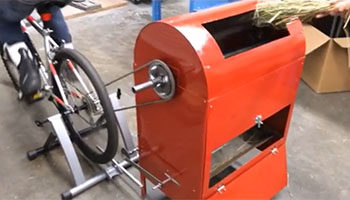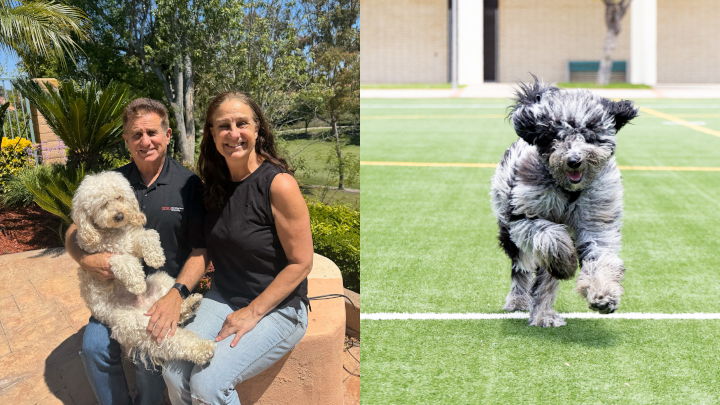SDSU Students Sweep Social Innovation Prizes
Three teams won $22,500 in investor funding at the 2014 Social Innovation Challenge.

Three teams made up of socially conscientious engineers, designers, and business professionals from San Diego State University received investment funding during last week’s 2014 Social Innovation Challenge hosted by the University of San Diego. Previously a competition limited exclusively to students from USD, this year it also included a regional component with $22,500 in prize money on the line.
SDSU’s teams — all members of the Zahn Innovation Center — swept the available prize money in the regional track, beating out 39 other teams from Point Loma Nazarene University, San Diego City College, and the University of California, San Diego.
The three winning SDSU teams are:
- W.E. Do Good’s Teff Thresher, which has created an affordable grain thresher for resource-strapped Ethiopian farmers ($10,000).
- Art Without a Roof, which features artwork produced by homeless youth printed on clothing and returns part of the profit to homeless education opportunities ($2,500).
- VENA, which has created a power-free water condenser that can provide water for people living in extreme arid conditions ($10,000 in investors’ prize money and $1,000 for being the audience favorite).
When the going gets teff
Robert Schneider, a senior mechanical engineering major who works with W.E. Do Good, explained that teff, a type of annual grass whose poppy seed–sized grain can be used in cooking, is the second largest crop grown in Ethiopia behind coffee. Threshing the usable grain from the grass, though, is a laborious, time-consuming process for the approximately 6 million Ethiopian farmers who grow it.

“We picked teff because it is the most difficult crop to harvest,” Schneider said. “The whole village is needed for the traditional method of growing and threshing it,” which involves spreading a layer of dirt and animal feces atop the crop before drying and beating it to separate the grain from the chaff.
Not only is the process less efficient than modern automated threshing, it’s unsanitary, yields less usable grain, and leads to many Ethiopian children missing months of school to help their families with the harvest.
Most farmers can’t afford technologically advanced modern threshers, but many likely could afford the human-powered threshing machine created by W.E. Do Good. The machine, recently named the Mairgaa Machine (mairgaa means “right” in Amharic), threshes the raw grass with six spinning flat blades, then collects the separated grains through a sieve.
One Mairgaa Machine can do the work of about 28 people, Schneider said, freeing children to attend school and providing more return on investment for the farmers.
The first iteration of the machine was powered by a bicycle and cost about $200 to produce. Their latest design explores ditching the bicycle in favor of a cheaper, lever-powered mechanism.
Schneider said the competition’s judges and investors responded to the project because, quite simply, it works.
“The thresher kind of sells itself,” he said. “They loved the practicality of it. It made sense.”
The power of art
Art Without a Roof (AWF) aims to help children closer to home. There are some 2,000 homeless youth in San Diego, said team chief information officer Ryan Zomorodi, a business management student at SDSU who will be graduating this semester. By turning the artistic creativity of these youth into clothing designs, AWF is earning money and reinvesting it into educational opportunities for the young artists.
Zomorodi, along with fellow team members and SDSU students Matthew Wayne and Mitchell Gilbert, formed a partnership with San Diego’s Monarch School, a K-12 school for young people affected by homelessness. Students at Monarch who participate in this program work with an art therapist to create paintings, drawings, and other artistic expressions.
Art Without a Roof prints clothing featuring artwork created by homeless youth, then reinvests a portion of its profits back into homeless education and art therapy.
“The art they design tends to resemble their lives in some way, and to be able to express themselves to the rest of the world is truly inspiring,” Zomorodi said.
Production has yet to begin, but when it does, AWF will market a line of t-shirts featuring the artwork created by Monarch’s students. The backs of the shirts will also print a paragraph detailing the artist’s personal life story under the tag.
The team will invest 25 percent of its profits into scholarships for the artists, as well as into improving and expanding the art therapy program at the school.
“The model we put in place for our clothing company enables a creative and therapeutic outlet for homeless and at-risk youth to express and empower themselves, while encouraging entrepreneurship and the importance of furthering education,” Zomorodi said.
Water, water everywhere
The VENA water condenser was inspired by the incredible adaptability of the cactus. Cactus spines collect nighttime moisture via condensation, similar to dew forming on blades of grass. The VENA device mimics these spines with copper alloy filaments that are even more effective at drawing out moisture from ambient air.
A copper alloy cable running through the middle of the device sinks several feet into the cool ground, conducting heat away from the above-ground copper filaments, allowing them to stay cooler than the surrounding air. This causes dew to collect on the filaments throughout the day. The condensed water then drips into a collection basin buried beneath the device. It accomplishes all of this without any power source.
On average, each VENA device can collect between 18 and 21 liters of water per day. For communities living in extremely arid parts of the world such as Lima, Peru and Nairobi, Kenya, VENA devices could bring welcome relief from the constant threat of drought.



